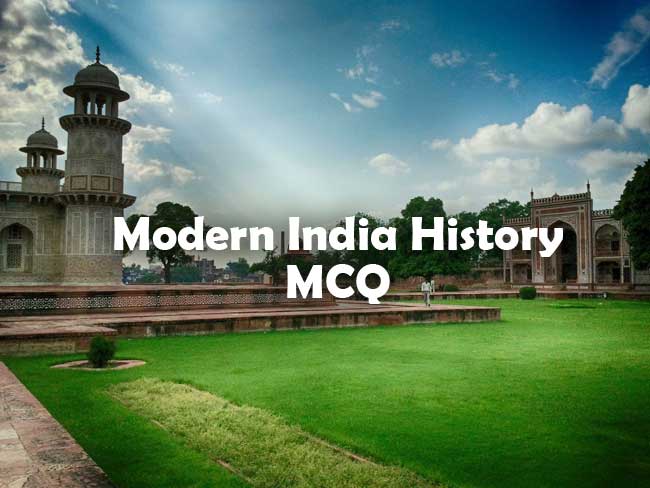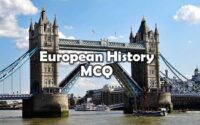Modern India History Questions and Answers
Last 5 years Modern India History Questions and Answers Papers provided here. Candidates who are applied for the competitive exam can check and download the Modern history of India MCQ from here. We have updated Modern history of India topics GK Papers to present you a scheme on how to plan for the exam.

Download pdf Indian Modern history quiz Last Year Solved Question Papers from the link provided. Therefore, if you are among the one who is searching for the Indian Modern history quiz Old Papers, then you can check here.
Hence, go through the following sections and download the Modern India quiz Model General Knowledge Question Papers Pdf. Interested aspirants can also check the Modern India quiz Test Pattern.
Questions and Answers on Modern India History
1. Mahatma Gandhi got his inspiration for Civil Disobedience from :
(A) Tuoreau
(B) Ruskin
(C) Confucius
(D) Tolstoy
2. The first Indian selected for Indian Civil Service was :
(A) Surendra Nath Banerji
(B) Sarojini Naidu
(C) Lala Lajpat Rai
(D) C.R. Das
3. The system of communal electorate in India was first introduced by :
(A) Indian Council Act of 1892.
(B) Minto-Morley reforms of 1909
(C) Montagu-Chelmsford reforms of 1919
(D) Government of India of 1935
4. Who represented India in the Second Round Table Conference?
(A) Aruna Asaf Ali
(B) Sucheta Kripalani
(C) Sarojini Naidu
(D) Kalpana Joshi
5. What was the ultimate goal of Mahatma Gandhi’s Salt Satyagraha?
(A) repeal of Salt Satyagraha
(B) curtailment of the Government’s power
(C) economic relief to the common people
(D) ‘Purna Swaraj’ for India
6. Who persuaded the ratings of the RIN (Royal India Navy) to surrender on the 23rd February 1946?
(A) Mahatma Gandhi
(B) Jawaharlal Nehru and Maulana Abul Kalam Azad
(C) Vallabh Bhai Patel and M.A. Jinnah
(D) Morarji Desai and J.B. Kripalani
7. On September 20, 1932 Mahatma Gandhi began a fast unto death in Yervada Jail against :
(A) British repression of the Satyagrahis.
(B) Violation of the Gandhi-Irwin Pact.
(C) Communal award of Ramsay MacDonald.
(D) Communal riots in Calcutta.
8. In 1939, for the first time, Gandhiji tried out his specific techniques of controlled mass struggle in a native state. He allowed a close associate of his to lead a satyagraha. Who was he?
(A) K. T. Bhashyam in Mysore
(B) Jamnalal Bajaj in Jaipur
(C) Vallabh Bhai Patel in Rajkot
(D) Nebakrushna Chaudhri in Dhenkanal
9. One time associate of Mahatma Gandhi, broke off from him and launched a radical movement called ‘self-respect movement’. Who was he ?
(A) P. Thyagaraja Shetti
(B) Chhatrapati Maharaj
(C) E.V. Ramaswamy Naicker
(D) Jyotirao Govindrao Phule
10. The first attempt to introduce a representative and popular element in the governance of India was made through :
(A) Indian Council Act, 1861
(B) Indian Council Act, 1892
(C) Indian Council Act, 1909
(D) Government of India Act, 1919
11. What did Jyotiba Phule’s Satyashodhak Samaj attempt in the last century?
(A) Saving the lower castes from hypocritical Brahmans and their opportunistic scriptures
(B) Attacking the caste system
(C) Led an anti-landlord and antimahajan upsurge in Satara
(D) Separate representation for untouchables
12. In which of the following movements did Mahatma Gandhi make the first use of Hunger Strike as a weapon?
(A) Non-Cooperation Movement, 1920-22
(B) Rowlatt Satyagraha, 1919
(C) Ahmedabad Strike, 1918
(D) Bardoli Satyagraha
13. Who led the Salt Satyagraha Movement with Gandhi?
(A) Annie Besant
(B) Mridula Sarabhai
(C) Muthu Lakshmi
(D) Sarojini Naidu
14. Sati was prohibited by
(A) Warren Hastings
(B) Lord Wellesley
(C) Lord William Bentinck
(D) Lord Dalhousie
15. The Simon Commission was formed to review
(A) legislatures in India
(B) fitness of India for further reforms
(C) the position of the viceroy
(D) a Constitution for India
16. Where did Aurangzeb die?
(A) Ahmednagar
(B) Aurangabad
(C) Allahabad
(D) Lahore
17. When was the first train steamed off in India ?
(A) 1848
(B) 1853
(C) 1875
(D) 1880
18. Which one of the following libraries has the largest collection of manuscripts of historical value?
(A) Khuda Baksh Oriental Public Library
(B) Tanjavur Maharaja Serfoji Saraswati Mahal Library
(C) Asiatic Society Library
(D) Rampur Raza Library
19. In which of the following systems of land settlement adopted by the English did provide more protection to the interests of farmers ?
(A) Permanent Settlement of Bengal
(B) Ryotwari Settlement of Madras
(C) Zamindari Settlement of Central States
(D) Malgujari (land revenue) Setternent of United State
20. Which of the following pairs contributed significantly to integrate the princely states into Indian Union ?
(A) Sardar Patel and Jawaharlal Nehru
(B) Sardar Patel and V.P. Menon
(C) Sardar Patel and Mahatma Gandhi
(D) Sardar Patel and K.M. Munsi
| Ancient History | Modern History |
| Medieval History | Indian History |
21. When was first telegraph line started in India ?
(A) 1851
(B) 1875
(C) 1884
(D) 1900
22. The Home Rule Leagu was started by
(A) Mahatma Gandhi
(B) Bal Gangadhar Tilak
(C) Jawahar Lal Nehru
(D) Rajendra Prasad
23. When did the British Govt. start ruling India directly ?
(A) After the Battle of Plassey
(B) After the Battle of Panipat
(C) After the War of Mysore
(D) After Sepoy Mutiny
24. What did the Hunter Commission appointed by the Viceroy probe ?
(A) Bardoli Satayagraha
(B) Khilafat Agitation
(C) Jallianwala Bagh tragedy
(D) Chauri Chaura incident
25. Who was the Chairman of the Union Powers Committee of the Constituent Assembly of India?
(A) Sardar Vallabhbahi Patel
(B) Dr. B.R. Ambedkar
(C) Sir Alladi Krishnaswami Ayyar
(D) Pt. Jawaharlal Nehru
26. From where did Acharya Vinoba Bhave start the Individual Satyagraha in 1940?
(A) Nadiad in Gujarat
(B) Pavnar in Maharashtra
(C) Adyar in Tamil Nadu
(D) Guntur in Andhra Pradesh
27. Which British Governor General introduced Postage Stamp in India ?
(A) Lord Dalhousie
(B) Lord Auckland
(C) Lord Canning
(D) Lord William Bentinck
28. The first telegraph line between Calcutta and Agra was opened in
(A) 1852
(B) 1853
(C) 1854
(D) 1855
29. The original name of Swami Dayananda Saraswati was
(A) Abhi Shankar
(B) Gowri Shankar
(C) Daya Shankar
(D) Mula Shankar
30. The Swadeshi Movement was launched
(A) as a protest against division of Bengal
(B) with a view to improve the economic condition of the people by encouraging consumption of Indian goods
(C) as a protest against the massacre of Indian people at Jallianwala Bagh
(D) due to the failure of the British Government to introduce responsible Government in India
31. The 19th Century reawakening in India was confined to the
(A) Priestly class
(B) Upper middle class
(C) Rich peasantry
(D) Urban landlords
32. Who was the first Indian to be elected to the British Parliament?
(A) Dadabhai Naoroji
(B) Gopala Krishna Gokhale
(C) Bipin Chandra Pal
(D) Lala Lajpat Rai
33. Who introduced the permanent settlement in Bengal ?
(A) Lord Cornwallis
(B) Lord Dalhousie
(C) William Bentinck
(D) Lord Curzon
34. When was the first passenger train run in India ?
(A) January 1848
(B) April 1853
(C) May 1857
(D) April 1852
35. Who designed the national flag of Independent India ?
(A) Bankim Chandra Chatterjee
(B) Rabindranath Tagore
(C) Mahatma Gandhi
(D) Pingali Venkaiah
36. Which of the following European Colonisers did not have a settlement on the Eastern Coast of India ?
(A) French
(B) Portuguese
(C) Dutch
(D) Danish
37. In which session of Indian National Congress the tricolour flag was unfurled for the first time ?
(A) Calcutta Session, 1920
(B) Annual Session of Congress at Nagpur, 1920
(C) Lahore Congress, 1929
(D) Haripura Congress Conference, 1938
38. Which among the following regulations made English as a medium of education compulsory in government aided schools and colleges ?
(A) Pitts India Act, 1784
(B) Educational Despatch, 1854
(C) Macaulay Minute, 1835
(D) Regulating Act, 1773
39. During colonial period, British capital was mainly invested in :
(A) Infra structure
(B) Industry
(C) Agriculture
(D) Services
40. M. A. Jinnah, in his early political life–
(A) supported two nation theory
(B) initiated Hindu-Muslim unity
(C) imagined Pakistan as an independent State
(D) was a communalist
41. Who among the following controlled maximum trade in the western coastal region during 17th century ?
(A) Portuguese
(B) Dutch
(C) The house of Jagat Seth
(D) Mulla Abdul Gaffar
42. Given below are the names of prominent leaders and their respective operational areas during the revolt period. Select the incorrect pair.
(A) Rani Laxmibai—Indore
(B) Khan Bahadur Khan—Ruhelkhand
(C) Kunwar Singh—Sahabad
(D) Nana Saheb—Kanpur
43. Who was the National leader who wrote History of India on the walls of the Andaman Cellular Jail ?
(A) Nandanlal Bose
(B) Ambedkar
(C) Vir Savarkar
(D) Jyotiba Phule
44. The ‘Doctrine of Lapse’ was first applied to the Princely State of
(A) Satara
(B) Jhansi
(C) Oudh
(D) Jaunpur
45. The Indian Universities were first founded in the time of
(A) Macaulay
(B) Warren Hastings
(C) Lord Canning
(D) Lord William Bentinck
46. One of the following was not involved in the Chittagong Armoury Raid, 1934. Who was he?
(A) Kalpana Dutt
(B) Surya Sen
(C) Pritialata Woddedar
(D) Dinesh Gupta
47. Which of the following events made the English East India Company the legitimate masters of the Bengal Suba ?
(A) Battle of Buxar, 1764
(B) Battle of Plassey, 1757
(C) Farrukh Siyar’s Farman, 1717
(D) Ibrahim Khan’s Farman, 1690
48. Apart from the Quit India Movement which started on 9th August 1942, what other sensational activity of the freedom fighters was done on 9th August?
(A) Salt Satyagraha
(B) Boycott of Simon Commission
(C) Champaran Satyagraha
(D) Kakori Mail train “robbery”
49. Which of the following treaties brought an end to the independent existence of Peshwa Baji Rao II ?
(A) The Treaty of Purandhar
(B) Convention of Wadgaon
(C) Treaty of Bassein
(D) Treaty of Salbai
50. Which Indian statesman used these magic words, “Long years ago we made a tryst with destiny, and now the time comes when we shall redeem our pledge….” ?
(A) Mohandas Karamchand Gandhi
(B) Sardar Vallabhbhai Patel
(C) Netaji Subhas Chandra Bose
(D) Jawaharlal Nehru
51. Satyagraha finds expression in
(A) Sudden outbursts of violence
(B) Armed conflicts
(C) Non-cooperation
(D) Communal riots



